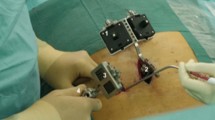Abstract
Introduction
Of late, computer-assisted surgery has become a novel challenge for orthopedic surgeons. However, for orthopedic interventions magnetic resonance (MR) fluoroscopy is in its early stages of development. The authors have developed an innovative passive navigation concept, which is potentially applicable for many magnetic resonance image (MRI)-guided musculoskeletal interventions. With this method, no switching between different planes is required, since the cross-sectional modality of the MRI is used as a new navigation approach.
Materials and methods
This method was mainly evaluated in retrograde drilling of artificial osteochondral lesions of the talus as an example of difficult navigation in drill placement due to poor visualization with X-ray and complex anatomy. To accomplish this objective, a passive navigation device was constructed and evaluated in nine cadaveric ankle joint specimens. Feasibility and accuracy of navigated drillings were evaluated.
Results
The interactive high-field MR fluoroscopy and the passive aiming device allow precise drilling of osteochondral lesions of the talus, despite the complex anatomy of the ankle. Drillings could be performed with an accuracy of 1.6 mm. The drilling guide was safe and easy to handle.
Conclusion
The MR-assisted retrograde drilling of osteochondral lesions may enable precise and safe treatment without radiation exposure. This passive navigation technique for MR fluoroscopy is potentially applicable for many orthopedic interventions and may present an alternative to other navigation methods. Especially, the treatment of pediatric and adolescent patients may benefit from the typical MRI properties.







Similar content being viewed by others
References
Bale RJ, Hoser C, Rosenberger R, Rieger M, Benedetto KP, Fink C (2001) Osteochondral lesions of the talus: computer-assisted retrograde drilling—feasibility and accuracy in initial experiences. Radiology 218(1):278–282
Carrino JA, Khurana B, Ready JE, Silverman SG, Winalski CS (2007) Magnetic resonance imaging-guided percutaneous biopsy of musculoskeletal lesions. J Bone Joint Surg Am 89(10):2179–2187
Carrino JA, Blanco R (2006) Magnetic resonance—guided musculoskeletal interventional radiology. Semin Musculoskelet Radiol 10(2):159–174
Genant JW, Vandevenne JE, Bergman AG, Beaulieu CF, Kee ST, Norbash AM, Lang P (2002) Interventional musculoskeletal procedures performed by using MR imaging guidance with a vertically open MR unit: assessment of techniques and applicability. Radiology 223(1):127–136
Kim PK, Zhu X, Houseknecht E, Nickolaus D, Mahboubi S, Nance ML (2005) Effective radiation dose from radiologic studies in pediatric trauma patients. World J Surg 29(12):1557–1562
Koenig CW, Duda SH, Truebenbach J, Schott UG, Maurer F, Claussen CD, Pereira PL (2001) MR-guided biopsy of musculoskeletal lesions in a low-field system. J Magn Reson Imaging 13(5):761–768
Koskinen SK, Parkkola RK, Karhu J, Komu ME, Kormano MJ (1997) Orthopedic and interventional applications at low field MRI with horizontally open configuration. A review. Radiologe 37(10):819–824
Messmer P, Gross T, Suhm N, Regazzoni P, Jacob AL, Huegli RW (2004) Modality-based navigation. Injury 35(Suppl 1):SA24–SA29
Moche M, Trampel R, Kahn T, Busse H (2008) Navigation concepts for MR image-guided interventions. J Magn Reson Imaging 27(2):276–291
Ojala R, Sequeiros RB, Klemola R, Vahala E, Jyrkinen L, Tervonen O (2002) MR-guided bone biopsy: preliminary report of a new guiding method. J Magn Reson Imaging 15(1):82–86
Sanders R, Koval KJ, DiPasquale T, Schmelling G, Stenzler S, Ross E (1993) Exposure of the orthopaedic surgeon to radiation. J Bone Joint Surg Am 75:326–330
Schulz T, Tröbs RB, Schneider JP, Hirsch W, Puccini S, Schmidt F, Kahn T (2005) Pediatric MR-guided interventions. Eur J Radiol 53(1):57–66
Sequeiros RB, Ojala R, Kariniemi J, Perälä J, Niinimäki J, Reinikainen H, Tervonen O (2005) MR-guided interventional procedures: a review. Acta Radiol 46(6):576–586
Smith KA, Carrino J (2008) MRI-guided interventions of the musculoskeletal system. J Magn Reson Imaging 27(2):339–346
Acknowledgments
The project is financed by a public grant (TSB Technologiestiftung Berlin-Zukunftsfond Berlin). Co-financed by the European Union-fund for regional development. Usage of the cadaveric specimens was approved and authorized by the institutional review board of University Hospital Berlin, Charité. The authors retained full control of all data collected and information submitted for publication.
Conflict of interest statement
There is no conflict of interest.
Author information
Authors and Affiliations
Corresponding author
Rights and permissions
About this article
Cite this article
Bail, H.J., Teichgräber, U.K.M., Wichlas, F. et al. Passive navigation principle for orthopedic interventions with MR fluoroscopy. Arch Orthop Trauma Surg 130, 803–809 (2010). https://doi.org/10.1007/s00402-009-1006-6
Received:
Published:
Issue Date:
DOI: https://doi.org/10.1007/s00402-009-1006-6




